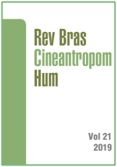Determinação do limiar da frequência cardíaca a partir da cinética da frequência cardíaca durante o exercício graduado máximo em jogadores de futebol
DOI:
https://doi.org/10.1590/1980-0037.2019v21e57829Resumo
O objetivo do presente estudo foi identificar o limiar de frequência cardíaca baseado na cinética da frequência cardíaca durante o exercício máximo graduado em jogadores de futebol. Vinte e seis jogadores de futebol masculino realizaram um teste de exercício máximo (protocolo de Bruce) em uma esteira motorizada. O consumo de oxigênio (VO2) e a freqüência cardíaca (FC) foram monitorados, registrados e reamostrados a 3,5Hz. O limiar ventilatório (LV), a compensação respiratória (CR), os pontos de deflexões da frequência cardíaca (PDFC1 e PDFC2) e o limiar da cinética da frequência cardíaca (LCFC) foram determinados por métodos computadorizados. A variabilidade da frequência cardíaca (VFC) foi avaliada no domínio da frequência. A média do LCFC foi de 89,9 ± 1,2% do VO2 de pico. O LCFC demonstrou correlações e diferenças significativas em relação ao PDFC1 (r = 0,46) e ao LV (r = 0,51), mas não foi diferente e altamente correlacionado com PDFC2 (0,98) e CR (0,90). Os gráficos de Bland Altman mostraram todos os atletas em 95% dos limites de concordância, e o coeficiente de correlação intraclasse apresentou boas concordâncias entre os pontos obtidos com o LCFC em comparação com o PDFC2 (0,96) e CR (0,98). A LCFC foi altamente correlacionada com PDFC2 e CR, sugerindo que poderia ser um marcador de fadiga cardiorrespiratória.
Referências
Wasserman K, McIlroy MB. Detecting the Threshold of Anaerobic Metabolism in Cardiac Patients during Exercise. Am J Cardiol 1964;14:844-52.
Weston SB, Gabbett TJ. Reproducibility of ventilation of thresholds in trained cyclists during ramp cycle exercise. J Sci Med Sport 2001;4(3):357-66.
Barstow TJ, Casaburi R, Wasserman K. O2 uptake kinetics and the O2 deficit as related to exercise intensity and blood lactate. J Appl Physiol 1993;75(2):755-62.
Barstow TJ, Jones AM, Nguyen PH, Casaburi R. Influence of muscle fiber type and pedal frequency on oxygen uptake kinetics of heavy exercise. J Appl Physiol 1996;81(4):1642-50.
Conconi F, Ferrari M, Ziglio PG, Droghetti P, Codeca L. Determination of the anaerobic threshold by a noninvasive field test in runners. J Appl Physiol Respir Environ Exerc Physiol 1982;52(4):869-73.
Sietsema KE, Ben-Dov I, Zhang YY, Sullivan C, Wasserman K. Dynamics of oxygen uptake for submaximal exercise and recovery in patients with chronic heart failure. Chest 1994;105(6):1693-700.
Marques-Neto SR, Maior AS, Maranhao Neto GA, Santos EL. Analysis of heart rate deflection points to predict the anaerobic threshold by a computerized method. J Strength Cond Res 2012;26(7):1967-74.
Guilhem G, Dorel S, Hug F. Effects of a prior short simulated training session on the subsequent occurrence of ventilatory thresholds. J Sci Med Sport 2009;12(2):273-9.
Bruce RA, Kusumi F, Hosmer D. Maximal oxygen intake and nomographic assessment of functional aerobic impairment in cardiovascular disease. Am heart J 1973;85(4):546-62.
Bland JM, Altman DG. Statistical methods for assessing agreement between two methods of clinical measurement. Lancet 1986;1(8476):307-10.
Fell JW. The modified D-max is a valid lactate threshold measurement in veteran cyclists. J Sci Med Sport 2008;11(5):460-3.
Santos EL, Novaes JS, Reis VM, Giannella-Neto A. Low sampling rates bias outcomes from the Wingate test. Int J Sports Med 2010;31(11):784-9.
Gledhill N, Cox D, Jamnik R. Endurance athletes' stroke volume does not plateau: major advantage is diastolic function. Med Sci Sports Exerc 1994;26(9):1116-21.
Pokan R, Hofmann P, von Duvillard SP, Beaufort F, Smekal G, Gasser R, et al. The heart rate performance curve and left ventricular function during exercise in patients after myocardial infarction. Med Sci Sports Exerc 1998;30(10):1475-80.
Conconi F, Grazzi G, Casoni I, Guglielmini C, Borsetto C, Ballarin E, et al. The Conconi test: methodology after 12 years of application. Int J Sports Med 1996;17(7):509-19.
Barstow TJ, Buchthal S, Zanconato S, Cooper DM. Muscle energetics and pulmonary oxygen uptake kinetics during moderate exercise. J Appl Physiol 1994;77(4):1742-9.
Faisal A, Beavers KR, Robertson AD, Hughson RL. Prior moderate and heavy exercise accelerate oxygen uptake and cardiac output kinetics in endurance athletes. J Appl Physiol 2009;106(5):1553-63.
Wasserman K, Whipp BJ, Koyl SN, Beaver WL. Anaerobic threshold and respiratory gas exchange during exercise. J Appl Physiol 1973;35(2):236-43.
Perlini S, Solda PL, Piepoli M, Sala-Gallini G, Calciati A, Finardi G, et al. Determinants of respiratory sinus arrhythmia in the vagotomized rabbit. Am J Physiol 1995;269(3 Pt 2):H909-15.
Cottin F, Lepretre PM, Lopes P, Papelier Y, Medigue C, Billat V. Assessment of ventilatory thresholds from heart rate variability in well-trained subjects during cycling. Int J Sports Med 2006;27(12):959-67.
Pichon AP, de Bisschop C, Roulaud M, Denjean A, Papelier Y. Spectral analysis of heart rate variability during exercise in trained subjects. Med Sci Sports Exerc 2004;36(10):1702-8.
Blain G, Meste O, Bouchard T, Bermon S. Assessment of ventilatory thresholds during graded and maximal exercise test using time varying analysis of respiratory sinus arrhythmia. Br J Sports Med 2005;39(7):448-52.
Downloads
Publicado
Edição
Seção
Licença

Direitos Autorais para artigos publicados nesta revista são do autor, com direitos de primeira publicação para a revista. Em virtude da aparecerem nesta revista de acesso público, os artigos são de uso gratuito, com atribuições próprias, em aplicações educacionais e não-comerciais, desde que seja dada a atribuição. Esta obra foi licenciada com uma Licença Creative Commons Atribuição 4.0 Internacional - CC BY


